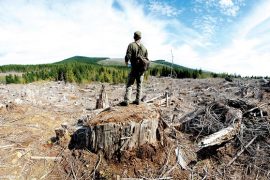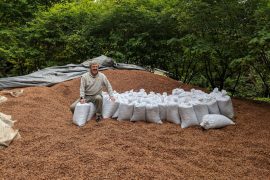In Oregon, there are six primary state forests. Altogether, these account for 3 percent of forestland in Oregon. The Tillamook State Forest is an 800-square-mile forest eighty miles west of Portland. As a state forest, the land is managed by the board of the Oregon Department of Forestry, which is composed of seven members appointed by the governor and confirmed by the state senate. The Department of Forestry is charged with managing forestlands to balance social, environmental and economic interests under a doctrine known as “greatest permanent value.” Last year, the Oregon Forestry Board approved a controversial new management plan for state forests that targets higher timber revenues (most of which go to counties) and lower reserves of old forest. This change in formula created a new rift between environmental groups, recreational groups and logging interests.
Bob Van Dyk
The Wild Salmon Center
In the coastal mountains of Northwest Oregon, surrounded by a patchwork of clear-cuts and roads, lies an oasis of temperate rainforest, crystal clear rivers, hundreds of miles of hiking trails, and some of the region’s last healthy wild runs of salmon and steelhead. The Tillamook and Clatsop State Forest is a 518,000-acre expanse of forests and rivers that belongs to all of us: the citizens of the state of Oregon.
Tragically, few people realize that the Tillamook may soon become one of the state’s newest industrial tree farms.
Cash-strapped coastal counties dependent on revenue from the forest have proposed opening the entire forest to clear-cut logging. At the same time, state legislators have introduced a bill in Salem that would mandate logging at 95 percent of industrial levels. But scientists agree that this level of logging in the slide-prone Tillamook would devastate fish and wildlife, increase flooding for Tillamook farmers and jeopardize access to clear drinking water for 400,000 Oregonians.
The Wild Salmon Center is leading a group of conservationists, recreational and sport fishermen, and hunters dedicated to preventing the destruction of the Tillamook, and finding a better balance between logging and conservation.
By law, our state forests are to provide the ‘greatest permanent value’ to the people of Oregon. On November 3, Gov. John Kitzhaber asked the Oregon Board of Forestry to find a balance between logging and conservation, and create permanent protected areas for fish and wildlife on the Tillamook.
Will the Tillamook join the endless patchwork of clear-cuts that blanket western Oregon? It is too early to tell. If this issue is important to you, please call or write your legislator and ask them to support the creation of reserves for fish and wildlife in the Tillamook and Clatsop State Forest.
Tim Josi
Tillamook County Commissioner
Recently, I was approached by a representative of the Wild Salmon Center who was interested in reaching an agreement on the management of the Tillamook State Forest. Instead, we’re faced with a lawsuit and further delay to important forest maintenance and revenues for the state.
The Wild Salmon Center and similar organizations have a history of using settlements as an incremental move to lock up more of our forest lands from timber harvesting. The results are overstocked forests that are diseased and prone to catastrophic forest fires, which emit tremendous amounts of carbon into our atmosphere. The dead trees decompose and emit even greater carbon dioxide.
On January19, Cascadia Wildlands, the Center for Biological Diversity and Audubon Society of Portland served notice of intent to sue the state of Oregon for violations to the Endangered Species Act regarding the Marbled Murrelet.
This group’s reality, however, is based on miscalculation. They say that they “have long encouraged the state to pursue other options on state forests to generate revenue; capitalizing on emerging carbon markets, conservation acquisitions and restoration thinning in young plantations.”
The reality is that emerging carbon markets don’t pencil out for wellmanaged forests; conservation easements mean locking up forests, and restoration thinning in young plantations is already happening.
About two years ago, the Oregon Department of Forestry reduced its workforce by 30 percent due to low harvest volumes and timber prices, a source of its funding. Today, the department is facing an additional budgetary crisis. The projected harvested levels within the State Forest Management Plan are not meeting its revenue expectations.
These organizations should be working on climate change issues, not locking up more forest land. This strategy ends in more forest fires and emission of additional carbon dioxide into our atmosphere.










‘Bigfoot Is Real’
http://bigfootsightings.org/friends-sasquatch-different/#comment-25296